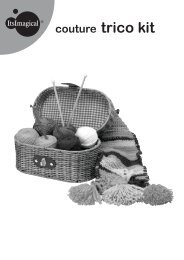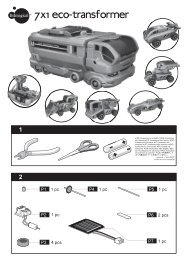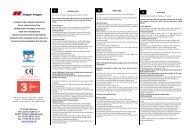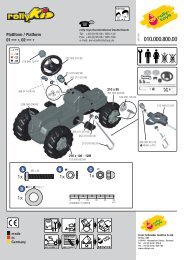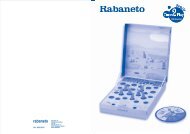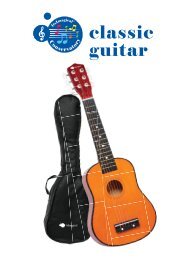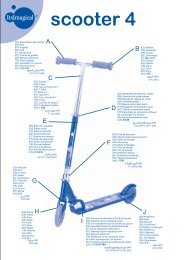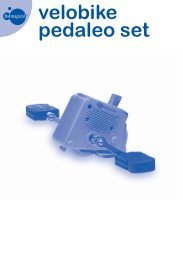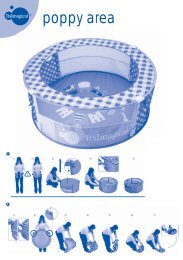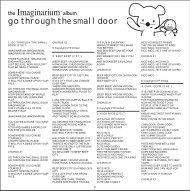Fabu-Ludo - Imaginarium
Fabu-Ludo - Imaginarium
Fabu-Ludo - Imaginarium
Create successful ePaper yourself
Turn your PDF publications into a flip-book with our unique Google optimized e-Paper software.
How to play: Each player chooses their motif:<br />
Boy or Girl. Then they place 4 pieces, 2 of<br />
each picture, in the 4 central squares on the<br />
board, with the identical pieces on a diagonal<br />
to each other. The Boy piece moves first, and<br />
then the players take turns, adding pieces to<br />
the board and following these rules:<br />
- The pieces can only be placed next to your<br />
opponents pieces or at the end of a row, in<br />
this latter case, there must be one of your<br />
pieces at the other end of the row where<br />
you place your piece. In addition, there can<br />
not be any empty squares between them.<br />
- Rows can be vertical, horizontal or<br />
diagonal. In this way the opposing counters<br />
are trapped between those already on the<br />
board and the new piece.<br />
- Whenever you place a piece and trap some<br />
opposing pieces, the opposing pieces are<br />
turned over and become yours.<br />
- If when you place one piece you trap<br />
opposing pieces in more than one row<br />
(horizontal, vertical or diagonal), all the<br />
trapped pieces are turned over.<br />
- If a player can not trap any opposing pieces<br />
then they miss a turn.<br />
The game is over when the board is full or<br />
when one of the players runs out of pieces.<br />
The winner is the player with the most pieces<br />
on the board. If each player has the same<br />
number of pieces on the board, it is a draw.<br />
GO!<br />
Contents:<br />
1 No. 2 Board<br />
64 Double pieces (Boy and Girl)<br />
2 Players.<br />
Objective of the game: To trap an opposing<br />
piece, surrounding it with your own pieces.<br />
How to play: In this case you play on the<br />
circles on the board between the squares.<br />
Each player, in turn, places their pieces on a<br />
circle, one by one, trying to surround one of<br />
the opponent's pieces.<br />
The winner is the first to surround an<br />
opposing piece.<br />
BACKGAMMON<br />
Contents:<br />
1 No. 9 Board<br />
2 Dice<br />
15 Crown pieces<br />
15 Princess hat pieces<br />
2 Players.<br />
Objective of the game: To be the first player<br />
to get all your pieces off the board.<br />
How to play: Each player chooses their<br />
pieces: Crown or Princess Hat, and places<br />
them on the board on the triangular shapes.<br />
The Crowns move in the direction shown in<br />
Figure 2, and the Hats move in the direction<br />
shown in Figure 3.<br />
The player with the highest score on the dice<br />
starts, and throws both dice in each turn. The<br />
player can move two pieces, each according<br />
to the number shown on one of the dice.<br />
Alternatively, they can move just one piece by<br />
the sum of the two dice. If the same number<br />
comes up on both dice, the player moves four<br />
times the number indicated by the dice.<br />
Piece on the central strip: when one piece is<br />
alone on a triangle, and one of the opponent's<br />
pieces lands on that triangle, the piece is<br />
taken and placed on the central band where it<br />
waits to re-enter the game in the next round.<br />
To get the piece back into the game, it has to<br />
land on a triangle with the player's own pieces<br />
(see Figure 4). If you can not do so, you do<br />
not move and it is the opponent's turn. If you<br />
can move it, you have the option of using the<br />
sum of the two dice to move it, or of using just<br />
one dice, and using the other dice to move a<br />
different piece.<br />
Rules:<br />
- You can not move your piece onto a triangle<br />
where there is more than one opposing<br />
piece.<br />
There may be times when it is impossible to<br />
move, and then you lose your turn and it is<br />
the opponent's turn.<br />
- Only 5 pieces can be put on one triangle.<br />
- Finally, if one of the pieces is on the last<br />
triangle, 1 is only needed on one of the dice<br />
to remove it from the board.<br />
SNAKES AND LADDERS<br />
Contents:<br />
1 No. 8 Board<br />
2 Dice<br />
1 Wolf piece<br />
1 Little pig piece<br />
1 Crown piece<br />
1 Princess hat piece<br />
For 2 to 4 players.<br />
Objective of the game: To be the first player<br />
to get to square 100.<br />
How to play: You can play with 1 dice, or 2 if<br />
you wish to play more quickly. The player who<br />
throws the highest number on the dice starts,<br />
and moves forward as many squares as<br />
shown on the dice. If you land on a ladder,<br />
you climb to the top of it; however, if you land<br />
on the head of a snake, you slide to the<br />
bottom of its tail.<br />
MILL<br />
Contents:<br />
1 No. 7 Board<br />
9 Wolf pieces<br />
9 Little pig pieces<br />
2 Players.<br />
Objective of the game: To put 3 of your own<br />
pieces in a line: horizontal or vertical, and to<br />
have your opponent finish with only 2 pieces<br />
on the board, or unable to move as all their<br />
pieces are blocked.<br />
How to play: Each player chooses their<br />
pieces: Wolf or Little Pig. Either player can<br />
start. Each player places their 9 pieces on the<br />
board. Then the pieces are moved along the<br />
lines to form rows of 3 pieces all the same.<br />
When a player has 3 pieces in a row, they<br />
remove one of the opponents pieces from the<br />
board. The winner is the first to capture 7<br />
opposing pieces, which means that the<br />
opponent can not make a row of 3.<br />
THE GOOSE GAME<br />
Contents:<br />
1 No. 1 Board<br />
1 Bear piece<br />
1 Little pig piece<br />
1 Boot piece<br />
1 Wolf piece<br />
For 2 to 4 players.<br />
Objective of the game: To be the first one to<br />
get to square 63.<br />
How to play: each player chooses their piece,<br />
and then decide who will go first (for example<br />
with one throw of a dice each). After that you<br />
play in turn, throwing the 2 dice and the sum<br />
of the 2 dice indicates the number of squares<br />
you can advance. Different things happen<br />
depending on the square you land on:<br />
- Squares 19 and 4_ Forest: the player<br />
misses 2 turns.<br />
- Square 31_ Swamp: the player does not<br />
have another go until one of other players<br />
land on the same square.<br />
- Square 56_Ogre: the player misses 3 turns.<br />
- Square 58_Skull: the player “dies” and, on<br />
their next turn, must start again from square<br />
1.<br />
The exact number must be thrown to land on<br />
square 63 - if you throw a higher number than<br />
you need, once you get to square 63 you<br />
must go backwards the extra number of<br />
squares.<br />
FOUR IN A ROW<br />
Contents:<br />
1 No. 5 Board<br />
21 Boy pieces<br />
21 Girl pieces<br />
2 Players.<br />
Objective of the game: To form a line with four<br />
pieces of the same colour. The lines can be<br />
horizontal, vertical or diagonal.<br />
How to play: each player chooses their pieces<br />
(Boy or Girl) and places them in turns on the<br />
board, always one next to another (with no<br />
spaces), trying to place 4 of their pieces in a<br />
line.<br />
The winner is the first to put four pieces in a<br />
row. If nobody succeeds in making a row, the<br />
game is a draw.<br />
CHINESE CHEQUERS<br />
Contents:<br />
1 No. 4 Board<br />
10 bear pieces<br />
10 Little pig pieces<br />
10 Boot pieces<br />
10 Crown pieces<br />
10 Wolf pieces<br />
10 Princess hat pieces<br />
2 to 6 players (never 5)<br />
Objective of the game: To move your 10<br />
pieces to the point of the star directly opposite<br />
where you start from.<br />
How to play: each player places their pieces<br />
on one of the points of the star. If there is an<br />
even number of players, they put their pieces<br />
on opposite points. When there are three<br />
players they alternate by putting pieces on<br />
one point, but not the next, etc.<br />
Taking turns, each player moves one piece,<br />
which can go in any direction (forwards,<br />
backwards, horizontal and diagonal). If one of<br />
the squares next to a piece is occupied,<br />
whether by one of the player's own pieces or<br />
an opponent's, the piece can be jumped over,<br />
as in Draughts (although the piece is not<br />
taken). A single piece can jump several times<br />
in a single turn.<br />
The winner is the first to place all their pieces<br />
on the point of the star directly opposite the<br />
one they start from. The other players may<br />
continue playing until they also reach this<br />
goal.<br />
LUDO (Parchis)<br />
Contents:<br />
1 No. 3 Board<br />
2 Dice<br />
4 Little pig pieces<br />
4 Wolf pieces<br />
4 Boot pieces<br />
4 Bear pieces<br />
For 2 to 4 players.<br />
Objective of the game: To get your four<br />
pieces to the centre of the board before your<br />
opponents'.<br />
How to play: Each player chooses 4 pieces<br />
and places them in their starting circles (the<br />
cabins of the three little pigs or the forest<br />
where the wolf lives). The person who throws<br />
the highest number with the dice begins.<br />
You have to throw a 6 with the dice in order to<br />
begin. When you throw a 6, place a piece on<br />
the exit arrow of your home, and move the<br />
piece the number of points shown on the<br />
other dice. You play by moving the pieces<br />
around the board clockwise. Example: if you<br />
throw a 6 and a 5, one of the piece leaves the<br />
circle and moves 5 squares on the board.<br />
Rules:<br />
- If a piece advances and lands on top of<br />
another player's piece, the player moving<br />
the piece can decide whether to send the<br />
other piece back to its starting circle, or<br />
whether to leave their piece on top of the<br />
opposing piece, allowing the opponent to<br />
move it around the board.<br />
- You can also start to move the piece again<br />
yourself whenever you want to.<br />
- When 2 different pieces advancing together<br />
land on a third piece, the third player can<br />
decide how to proceed.<br />
- A player who lands on one his or her own<br />
pieces may not advance with both at the<br />
same time.<br />
- If a player scores 2 points (double 1), and<br />
an opponent's piece is 2 squares in front on<br />
the board, then the opponent's piece can be<br />
sent back to its starting circle and the space<br />
occupied.<br />
- When the pieces arrive at the appropriate<br />
square, they reach the path that leads to<br />
their home. Once on this path, there are no<br />
obstacles. and nobody can take your piece,<br />
but you must throw the exact points to enter<br />
your home. If you throw too many points,<br />
once you reach your home you must move<br />
backwards the extra points. You must do<br />
this on each turn until you get the exact<br />
number.<br />
The winner is the first player to get all four<br />
pieces home and take the crown.<br />
SOLITAIRE<br />
Contents:<br />
1 No. 10 Board<br />
32 Girl pieces<br />
1 player<br />
Objective of the game: To get all the pieces<br />
off the board, except for one.<br />
How to play: There are various ways to start<br />
playing, and you can also create new<br />
combinations. To begin, place the pieces on<br />
the board based on the way of playing you<br />
have chosen.<br />
To remove a piece from the board, you have<br />
to jump over them, as in Draughts. The<br />
pieces always jump over the pieces to the<br />
side of them, towards an empty space,<br />
horizontally or vertically, but diagonals are not<br />
permitted.<br />
THREE IN A ROW<br />
Contents:<br />
1 No. 6 Board<br />
4 Castle pieces<br />
4 Forest pieces<br />
2 Players.<br />
Objective of the game: To form a vertical,<br />
horizontal or diagonal line with three pieces.<br />
How to play: Each player chooses their<br />
pieces (Castle or Forest) and they take turns<br />
to place them on the board, trying to place 3<br />
in a row. The winner is the first person to get<br />
three pieces in a row.<br />
Une coffret rempli de jeux avec les<br />
personnages de nos contes préférés ! Il y en<br />
a 11 différents !<br />
Contenu :<br />
5 plateaux doubles<br />
2 dés<br />
3 pochettes pour ranger les fiches<br />
4 pions Château<br />
4 pions Bois<br />
10 pions Ours<br />
10 pions Petit cochon<br />
10 pions Botte<br />
10 pions Loup<br />
15 pions Couronne<br />
15 pions Chapeau Princesse<br />
64 pions doubles (Petit garçon et Petite fille)<br />
REVERSI<br />
Contenu :<br />
1 plateau de jeu nº 2<br />
64 pions doubles (Petit garçon et Petite fille )<br />
2 joueurs<br />
But du jeu : Finir la partie en ayant davantage<br />
de pions que votre adversaire.<br />
Déroulement : Chaque joueur choisit son<br />
dessin : Petit garçon ou Petite fille. Puis, on<br />
place 4 pions, 2 de chaque dessin sur les<br />
quatre cases centrales du plateau de façon à<br />
ce que les pions semblables soient en<br />
diagonale. Le pion du Petit garçon se déplace<br />
en premier, puis chaque joueur se déplacera<br />
à tour de rôle, en ajoutant des pions sur le<br />
plateau et en suivant les règles suivantes :<br />
- Les pions ne peuvent se placer qu'à côté<br />
des pions adverses. A côté d'un pion<br />
adverse ou au bout d'une rangée, dans ce<br />
cas-là, l'un de nos pions doit être à<br />
l'extrémité opposée de celle où nous avons<br />
placé le pion. En plus, il ne peut pas y avoir<br />
de cases libres entre eux.<br />
- Cette rangée peut être verticale, horizontale<br />
ou diagonale. De cette façon, les pions<br />
adverses sont encadrés entre celui ou ceux<br />
qui étaient déjà sur le plateau et le nouveau<br />
pion .<br />
- Chaque fois qu'un joueur place un pion et<br />
en encadre d'autres, il retourne les pions<br />
encadrés et ces derniers lui appartiennent.<br />
- Si en plaçant un seul pion, on encadre des<br />
pions adverses sur plus d'une rangée<br />
(horizontale, verticale ou diagonale), on<br />
retournera tous les pions adverses ainsi<br />
encadrés.<br />
- Si un joueur ne peut encadrer aucun pion<br />
adverse, il perd son tour.<br />
La partie s'achève quand le plateau est<br />
entièrement occupé ou quand un des joueurs<br />
n'a plus de pions à poser sur le plateau. Dans<br />
tous les cas, le gagnant est celui qui a le plus<br />
de pions sur le plateau. Les joueurs sont à<br />
égalité, quand à la fin de la partie, il y a le<br />
même nombre de pions des deux dessins sur<br />
la table de jeu.<br />
p5<br />
p6



